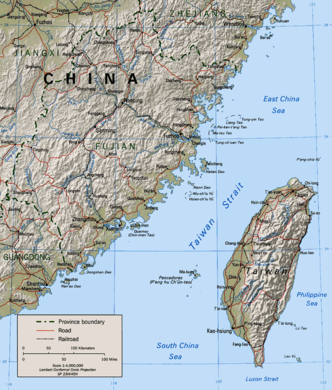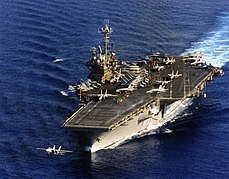| Third Taiwan Strait Crisis 台灣海峽飛彈危機 | |||||||
|---|---|---|---|---|---|---|---|
| Part of the Chinese Civil War | |||||||
 Taiwan Strait | |||||||
| |||||||
| Belligerents | |||||||
|
|
| ||||||
| Commanders and leaders | |||||||
|
|
| ||||||
| Units involved | |||||||
|
|
| ||||||
| Strength | |||||||
|
MIM-104 Patriot, MIM-23 Hawk, F-5 Tiger, F-CK-1, F-104 Starfighter, Knox-class frigate, Oliver Hazard Perry-class frigate, etc. USS Independence (CV-62), USS Nimitz (CVN-68), USS Belleau Wood (LHA-3), USS Bunker Hill (CG-52), etc. |
| ||||||
The Third Taiwan Strait Crisis, also called the 1995–1996 Taiwan Strait Crisis or the 1996 Taiwan Strait Crisis, was the effect of a series of missile tests conducted by the People's Republic of China (PRC) in the waters surrounding Taiwan, including the Taiwan Strait from 21 July 1995 to 23 March 1996. The first set of missiles fired in mid-to-late 1995 were allegedly intended to send a strong signal to the Republic of China government under President Lee Teng-hui, who had been seen as "moving its foreign policy away from the One-China policy", as claimed by PRC.[1] The second set of missiles were fired in early 1996, allegedly intending to intimidate the Taiwanese electorate in the run-up to the 1996 presidential election.
The crisis began when President Lee Teng-hui accepted an invitation from his alma mater, Cornell University to deliver a speech on "Taiwan's Democratization Experience". Seeking to diplomatically isolate the Republic of China, the PRC opposed such visits by ROC (Taiwanese) leaders. A year earlier, in 1994, when President Lee's plane had stopped in Honolulu to refuel after a trip to South America, the U.S. government under President Bill Clinton refused Lee's request for a visa. Lee had been confined to the military airfield where he landed, forcing him to spend a night on his plane. A U.S. State Department official called the situation "embarrassing" and Lee complained that he was being treated as a second-class leader.
After Lee had decided to visit Cornell, U.S. Secretary of State Warren Christopher assured PRC Foreign Minister Qian Qichen that a visa for Lee would be "inconsistent with [the U.S.'s] unofficial relationship [with Taiwan]." However, the humiliation from Lee's last visit caught the attention of many pro-Taiwan figures in the U.S. and this time, the United States Congress acted on Lee's behalf. In May 1995, a concurrent resolution asking the State Department to allow Lee to visit the U.S. passed the House on 2 May with a vote of 396 to 0 (with 38 not voting), and the Senate on 9 May with a vote of 97 to 1 (with 2 not voting).[2] The State Department relented on 22 May 1995. Lee spent 9–10 June 1995, in the U.S. at a Cornell alumni reunion as the PRC state press branded him a "traitor" attempting to "split China".[1]
The United States had not prepared the People's Republic of China for its policy reversal in granting a visa[3]: 224 and CCP general secretary Jiang Zemin was furious over the U.S.'s policy reversal. On 7 July 1995, PRC responded, the Xinhua News Agency announced missile tests would be conducted by the People's Liberation Army (PLA) and argued that this attitude would endanger the peace and safety of the region (Mainlander refers to it as the fourth Taiwan strait crisis[4]). At the same time, the PRC mobilized forces in Fujian. In the later part of July and early August, numerous commentaries were published by Xinhua and the People's Daily condemning Lee and his cross-strait policies.[citation needed]
From 21 July to 28 July, the Second Artillery Corps (SAC) conducted a round of missile launches in an area 36 miles north of Taiwan.[5]: 267 On 21 July, it launched two Dongfeng-15 missiles approximately 70 nautical miles from the coast of Taiwan.[5]: 267 On 22 July, SAC fired two missiles at an area 40 miles north of Taiwan.[5]: 267–268 On 24 July, it fired two more at the same area.[5]: 268 Simultaneously, the PRC concentrated naval and amphibious landing forces in the area of the strait and conducted military exercises.[5]: 268
The United States responded by sending two aircraft carrier groups to the vicinity of Taiwan.[3]: 224 In July 1995, USS Belleau Wood (LHA-3) transited the Taiwan Strait.[6]
From 15 August to 25 August, the East Sea Fleet deployed 59 naval vessels for exercises, during which the People's Liberation Army Air Force practiced 192 sorties.[5]: 268
The United States sent the USS O'Brien (DD-975) and USS McClusky FFG-41 through the strait on 11–12 December 1995.[6] Finally on 19 December 1995, the USS Nimitz (CVN-68) and her battle group passed through the straits.[6]
Between January and February 1996, the PRC concentrated 100,000 troops along the strait and conducted large scale exercises.[5]: 268 Tensions remained high in early 1996 as Taiwan prepared for its first presidential election and Lee Teng-hui ran on the Kuomintang's ticket.[5]: 268
On 8 March, the PRC fired more missiles 20 miles off Keelung and 29 miles off Kaohsiung.[5]: 268 Over 70 percent of commercial shipping passed through the targeted ports, which were disrupted by the proximity of the tests.[7][8]
The same day, United States President Clinton announced that the USS Independence CV-62 and her Carrier Battlegroup (Carrier Group Five),[9] returning to Japan from its visit to the Philippines, would deploy to international waters near Taiwan.[10] According to the Washington Post, that same day; the USS Bunker Hill CG-52 (which had detached from the Independence Battlegroup) along with a RC-135 Intelligence aircraft monitored the launch of 3 CSS-6 (DF-15) missiles from the PRC, two of them into shipping lanes near Kaohsiung and one fired directly over Taipei into a shipping lane near Keelung.[11]
On the following day, the PRC announced live-fire exercises to be conducted near Penghu from 12 to 20 March. On 11 March, the U.S. dispatched USS Nimitz CVN-68 and her battlegroup, Carrier Group Seven.[12][5]: 268 Nimitz and her battle group, along with Belleau Wood, sailed through the Taiwan Strait, while Independence did not.[13][14] In response to the U.S. moves, the PRC announced further exercises.[5]: 268
From 18 March to 25 March, the PRC conducted military exercises involving airplanes, guided missile destroyers, submarines, and 150,000 troops at Pingtan Island.[5]: 268–269 The exercises practiced amphibious landing, mountainous assaults, and included paratrooper exercises.[5]: 269
On March 23, 1996, Lee was elected Taiwan's president.[5]: 269
Jiang ordered the PLA to begin a ten-year modernization program.[3]: 225 Soon the People's Republic ordered Sovremenny-class destroyers from Russia, a Cold War-era class designed to counter U.S. Navy carrier battle groups, allegedly in mid-December 1996 during the visit to Moscow by Chinese Premier Li Peng. The PRC subsequently ordered modern attack submarines (Kilo class) and warplanes (76 Su-30MKK and 24 Su-30MK2) to counter the U.S. Navy's carrier groups.[citation needed]
The PRC's attempts at intimidation were counterproductive. Arousing more anger than fear, it boosted Lee by 5% in the polls, earning him a majority as opposed to a mere plurality.[15] The military tests and exercises also strengthened the argument for further U.S. arms sales to the ROC and led to the strengthening of military ties between the U.S. and Japan, increasing the role Japan would play in defending Taiwan.
During the military exercises in March, there were preoccupations in Taiwan that the PRC would occupy some small islands controlled by Taiwan, causing panic among many citizens. Therefore, many flights from Taiwan to the United States and Canada were full.[citation needed] The most likely target was Wuqiu (Wuchiu), then garrisoned by 500 soldiers. The outlying islands were placed on high alert.[16] The then secretary general of the National Security Council of Taiwan, Ting Mao-shih, flew to New York to meet Samuel Berger, Deputy National Security Advisor of the United States.[17]
In 1999, Major General Liu Liankun, a top Chinese military logistics officer, and his subordinate Senior Colonel Shao Zhengzhong were arrested, court-martialed and executed for disclosing to Taiwan that the missiles had unarmed warheads despite the Chinese government's claims.[18]


According to Sankei Shimbun series "Secret Records on Lee Teng-hui" dated 1 April 2019, Tseng Yong-hsien, Lee's National Policy Adviser, received a direct message from China official in early July 1995; "Our ballistic missiles will be launched toward Taiwan a couple of weeks later, but you guys don't have to worry." This was communicated to Lee soon after, to prevent escalation. Tseng, as an envoy of Lee, had met President Yang Shangkun in 1992 and had a secret connection with Ye Xuanning, Head of the Liaison Department of the PLA.[30]
The most likely target would be Wuchiu, above five miles off the eastern coast of China, the report said. The island has a garrison of 500 soldiers. To prepare for an attack, outlying islands have been placed on high alert, it said.
| South Asia |
| ||||||||||||||||||||||
|---|---|---|---|---|---|---|---|---|---|---|---|---|---|---|---|---|---|---|---|---|---|---|---|
| East Asia |
| ||||||||||||||||||||||
| Southeast Asia |
| ||||||||||||||||||||||
| Central Asia |
| ||||||||||||||||||||||
| Western Asia |
| ||||||||||||||||||||||
| Inter-continental conflict | |||||||||||||||||||||||
| Related topics | |||||||||||||||||||||||
Armed conflicts involving the People's Republic of China | |||||||||
|---|---|---|---|---|---|---|---|---|---|
| Mainland China |
| ||||||||
| Cross-Taiwan Strait (vs Taiwan) (after 1 Oct 1949) |
| ||||||||
| International |
| ||||||||
| See also | |||||||||
| Diplomatic posts | |
|---|---|
| Diplomacy |
|
| Conflicts | |
| Incidents |
|
| Legislation | |
| Organizations |
|
| Concepts |
|
| Related |
|
| Diplomatic posts |
|
|---|---|
| Diplomacy | |
| Incidents | |
| Military relations | |
| Legislation | |
| Related | |